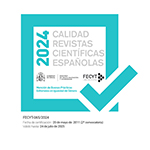Reflexiones acerca los segmentos medios en la sociedad colonial temprana de Córdoba del Tucumán (1573-1620)
Resumen
A partir del abordaje del proceso de configuración de la sociedad colonial temprana de la ciudad de Córdoba (perteneciente a la gobernación del Tucumán, Virreinato del Perú) entre 1573 y hasta 1620, el presente trabajo se centra en reflexionar acerca del conjunto de pobladores que no formaron parte de la élite de poder local (constituida por los vecinos beneméritos) ni tampoco integraron los segmentos inferiores o subalternos (indios de encomienda, esclavos, españoles y mestizos pobres). Se trata de un conjunto amplio y heterogéneo de personas que ha sido hasta el momento poco estudiado para América, algunos de cuyos rasgos distintivos se propone discutir y analizar, teniendo en cuenta que manifiesta un creciente peso demográfico a lo largo del período colonial y un rol destacado en la consolidación de las ciudades coloniales. Las fuentes analizadas son diversas y fragmentarias, entre las que podemos mencionar escrituras públicas protocolizadas, actas capitulares y expedientes judiciales de los siglos XVI y XVII.
Descargas
Descarga artículo
Licencia
La Revista Complutense de Historia de América, para fomentar el intercambio global del conocimiento, facilita el acceso sin restricciones a sus contenidos desde el momento de su publicación en la presente edición electrónica, y por eso es una revista de acceso abierto. Los originales publicados en esta revista son propiedad de la Universidad Complutense de Madrid y es obligatorio citar su procedencia en cualquier reproducción total o parcial. Todos los contenidos se distribuyen bajo una licencia de uso y distribución Creative Commons Reconocimiento 4.0 (CC BY 4.0). Esta circunstancia ha de hacerse constar expresamente de esta forma cuando sea necesario. Puede consultar la versión informativa y el texto legal de la licencia.











